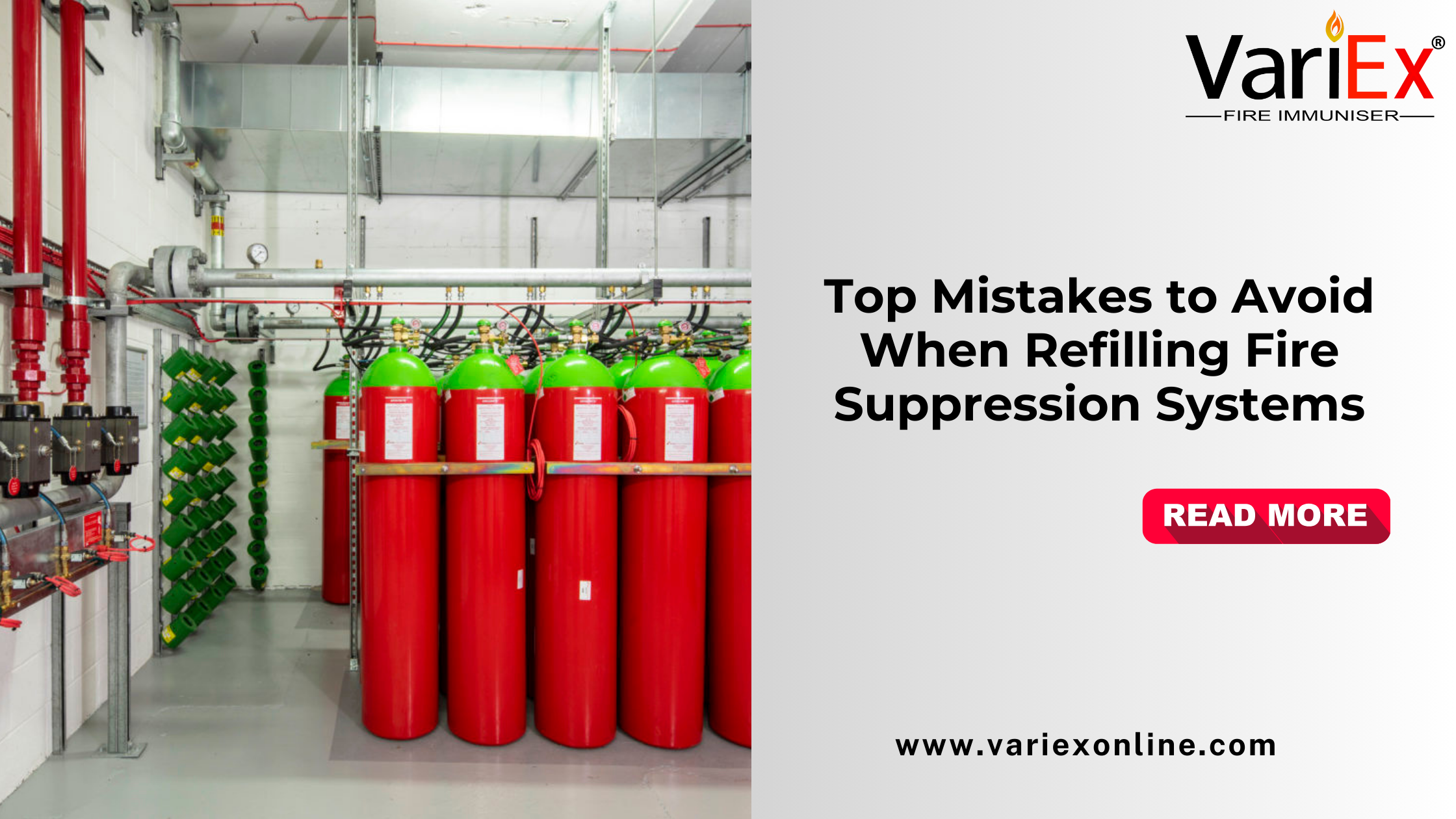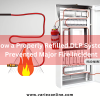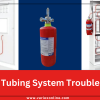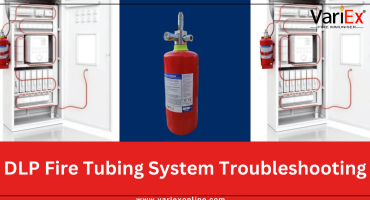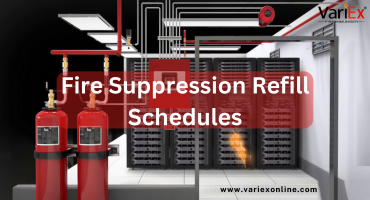![]()
Fire Immuniser
+91-7829629111
Email: info@variex.in
Varistor Technologies Pvt. Ltd.
Block-1, First Floor, Ardente Office One, Hoodi Circle, ITPL Main Road, Bengaluru, Karnataka 560048, IN
Top Mistakes to Avoid When Refilling Fire Suppression Systems
Top Mistakes to Avoid When Refilling Fire Suppression Systems
Fire suppression systems are crucial in mitigating damage and saving lives during a fire emergency. However, their effectiveness depends heavily on proper maintenance — especially timely and correct refilling. Refilling may sound simple, but even a minor mistake can render the entire system ineffective or non-compliant with safety regulations.
In this guide, we’ll dive into the most common mistakes to avoid when refilling fire suppression systems, so your facility stays protected, compliant, and efficient.
Delaying the Refill After System Discharge
One of the biggest and most dangerous mistakes is waiting too long to refill the system after a discharge. A fire suppression system is no longer functional after it has released its agent, leaving your property vulnerable.
Key Risk:
Total lack of fire protection until refilled.
Potential legal and insurance liabilities.
Using the Wrong Suppression Agent
Not all fire suppression agents are created equal. Using the wrong one can damage sensitive equipment or cause the system to malfunction entirely.
Common Agent Types:
| Fire Suppression Agent | Ideal For | Not Recommended For |
|---|---|---|
| CO₂ | Electrical & Industrial Fires | Occupied Spaces |
| FM-200 | Data Centers, Offices | Poorly Ventilated Areas |
| Wet Chemicals | Commercial Kitchens | Electronics |
| Inert Gases | Archives, Museums | Small Rooms |
Not Following Manufacturer or NFPA Guidelines
Each system comes with manufacturer-specific guidelines and must comply with NFPA (National Fire Protection Association) standards. Ignoring these can result in:
Failed inspections
System failure during an emergency
Legal non-compliance
DIY Refilling Without Proper Certification
Fire suppression system refilling should never be a DIY task unless you are a licensed and certified technician. Even trained facility staff should avoid handling it without proper authorization.
Why This Is Risky:
Incorrect pressure or agent volume
Risk of contamination
Voiding manufacturer warranty
Ignoring System Leak Checks After Refilling
After refilling, many neglect to perform a leak test, which can lead to:
Gradual agent loss
Increased refill costs
Hidden system failures
Always demand a hydrostatic pressure test or leak inspection after refilling, especially for gas-based systems.
Skipping Re-Calibration of Detection and Control Units
Many modern fire suppression systems are integrated with sensors and control panels. Refilling may affect these components. If not recalibrated:
The system may not detect fires promptly.
False alarms or failure to activate may occur.
Overlooking Proper Documentation and Tagging
After each refill, your fire suppression system must have updated service records, tags, and compliance logs.
Documentation Should Include:
Type and amount of agent used
Date of service
Technician’s credentials
Next scheduled maintenance
Refilling Without Verifying System Compatibility
Sometimes, agents evolve or change in formulation. Make sure that the new refill is:
Compatible with existing hardware
Approved for your system type
Within warranty recommendations
Infrequent Maintenance and Inspection Post-Refill
Just because the system was refilled doesn’t mean it’s good forever. Systems should be inspected semi-annually or annually, as per NFPA standards.
Hiring Inexperienced or Uncertified Technicians
Trying to cut costs by hiring uncertified personnel can lead to disaster. Always ask for:
Valid licenses
Insurance proof
Past client reviews
NFPA and local authority compliance
✅ Summary Table: Mistakes to Avoid & Recommended Action
| Mistake | Why It's Dangerous | Recommended Action |
|---|---|---|
| Delayed Refill | No fire protection | Refill immediately after discharge |
| Wrong Agent | System incompatibility | Use system-approved agent only |
| Skipping Guidelines | Legal and operational risk | Follow NFPA & manufacturer instructions |
| DIY Refilling | Safety and warranty issues | Hire certified technicians only |
| Ignoring Leak Tests | Hidden failures | Always test for leaks post-refill |
| No Calibration | Sensor errors | Recalibrate detection systems |
| Poor Documentation | Compliance issues | Maintain accurate refill records |
| Compatibility Issues | System malfunction | Verify refill compatibility |
| Lack of Inspection | Future system failure | Schedule regular inspections |
| Hiring Unqualified Staff | Improper refilling | Verify technician credentials |
Conclusion
Refilling your fire suppression system is more than just a maintenance task — it’s a critical safety procedure. Avoiding these common mistakes will not only ensure the system functions correctly during emergencies but also keep you legally compliant and financially protected.
Regular audits, certified technicians, and following the manufacturer’s guidelines are essential steps in keeping your fire suppression system reliable and ready.
Frequently Asked Questions
Only after discharge or when inspection reveals insufficient pressure or agent level. Some agents require periodic replacement based on the manufacturer’s instructions.
No. Refilling should only be performed by certified professionals to ensure safety and compliance with NFPA standards.
It may damage your equipment, void your warranty, or cause the system to malfunction in a real fire emergency.
Yes, especially for gas-based systems. Leaks can cause gradual agent loss and reduce system effectiveness.
Yes. The detection and control systems may need recalibration to function properly with the refilled system.
Final Say
At VariEx.in and VariexOnline.com, we specialize in supplying and installing top-quality fire fighting systems and equipment. From fire extinguishers to advanced suppression systems, we offer comprehensive solutions tailored to your needs. Our experienced team ensures precise installation and maintenance for optimal safety.
Trust VariEx for reliable fire protection. Contact us online or call 7829629111 to learn more.
We specialize in manufacturing, supplying, and distributing a comprehensive range of fire fighting equipment, including state-of-the-art fire extinguishers. Read our most searched blogs and find interesting information on topics such as how to use a fire extinguisher, how to calculate fire fighting water tank capacity, fire extinguisher refilling, obtaining a Fire NOC, understanding fire fighting systems, types of fire protection systems, the fire hydrant system, and the fire sprinkler system. These resources provide essential knowledge for ensuring safety and compliance with fire safety regulations. Additionally, you can explore guides on the maintenance of fire protection equipment, the latest advancements in fire safety technology, and best practices for fire risk assessment and management.
Our expertise extends to fire alarm systems, fire hydrant systems, and fire suppression systems, including fire sprinklers. Each product meets rigorous international standards for reliability and performance, ensuring effective fire safety products tailored to diverse applications and industries. Additionally, we are providing Fire Extinguisher Refilling and AMC services to ensure ongoing maintenance and operational readiness of fire safety equipment.
"WHAT YOU CAN READ NEXT"
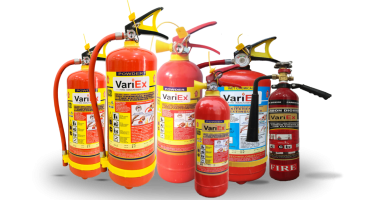 Read more +24 November 2023 in Fire Extinguisher
Read more +24 November 2023 in Fire ExtinguisherWhat types of fire extinguishers are available for different fire classes?
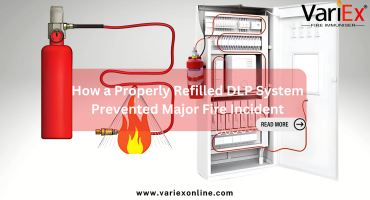 Read more +24 April 2025 in Fire Suppression
Read more +24 April 2025 in Fire Suppression

